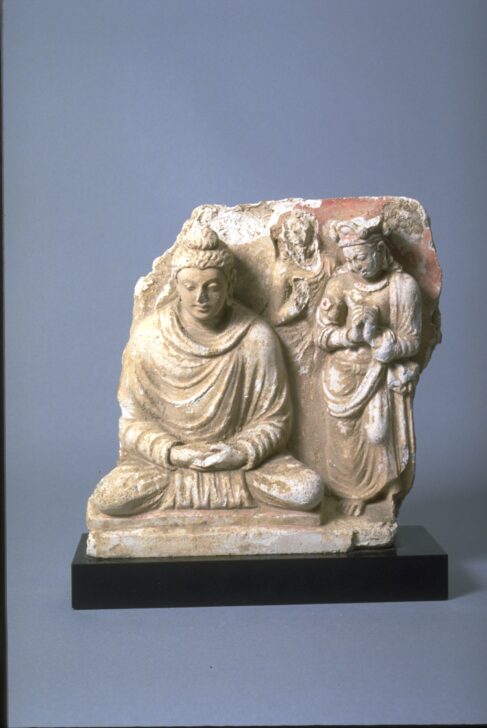Buddha, seated in the padmasana pose, in dhyana mudra, attended by Indra
Artist Unknown, Gandhara (Ancient Pakistan and Afghanistan)

Description
Buddha, Seated in the
Padmasana Pose, in Dhyana
Mudra, Attended by Indra
Gandhara (ancient Pakistan and
Afghanistan), 100–399
Stucco relief with traces of
polychromy
Museum purchase for the James
Marshall Plumer Memorial
Collection, 1961/2.83
In the fourth century BCE, Alexander the Great (356–323 BCE)
conquered Gandhara (now part of Pakistan and Afghanistan),
which was on the network of trade routes connecting East and
West known as the Silk Road. A continual association with
the West greatly affected Gandharan art, as can be seen in the
facial features, wavy hair, and draped, toga-like clothing of this
Buddha figure. Originally, this sculpture would have decorated
the exterior of a religious building or shrine in a monastic
complex, and would have been painted.
Standing beside the Buddha is a figure making the gesture
of worship. This is Indra, king of the Hindu gods. Brahma,
another important early Hindu deity, is likely to have
been on the Buddha’s other side. This grouping—typical
in Gandharan art—was intended to communicate the
superiority of the Buddha in relation to the Hindu gods
that were most prominent at that time. Indra’s contrapposto
(hip-shot) stance is yet another visual association with
Western art.
Winter 2024 Gallery Rotation
____________________
Gallery Rotation Fall 2013
Buddha Shakyamuni attended by Indra
Pakistan, ancient region of Gandhara
2nd–4th century
Stucco relief with traces of polychromy
Museum purchase for the James Marshall Plumer Memorial Collection, 1961/2.83
In the fourth century bce, Alexander the Great conquered Gandhara (now part of Pakistan and Afghanistan). Links with Greece and later with Rome endured for centuries as Gandhara lay on the trade routes, known as the Silk Road, that connected East and West. This continual association with the West greatly affected Gandharan art, as can be seen in the facial features, wavy hair, and draped toga-like clothing of this Buddha and the one to the right. Both these sculptures decorated the exteriors of religious buildings or shrines in monastic complexes and were painted in their original context.
Standing beside the Buddha is a figure making the gesture of worship. This is Indra, king of the Hindu gods. Brahma, another important early Hindu deity, is likely to have been on the other side of the Buddha. The Buddha flanked by these Hindu deities—a typical subject in Gandharan art—was intended to communicate the superiority of the Buddha in relation to the Hindu gods that were most prominent at that time. Indra’s contropposto (hip-shot) stance is yet another visual association with Western art.
Subject Matter:
The Buddha, seated in meditation, attended on his left by Indra, the king of the Brahmanical gods, and another figure damaged beyond recognition. Typically, the Brahmanical deity Brahma would have stood at Buddha's right side; together, Indra and Brahma worshipping the Buddha represent the capitulation of earlier faiths to Buddhism. This fragment would have originally decorated the wall of a stupa or shrine in a monastic compound.
Physical Description:
A fragment of a stucco relief sculpture.
Usage Rights:
If you are interested in using an image for a publication, please visit https://umma.umich.edu/request-image/ for more information and to fill out the online Image Rights and Reproductions Request Form.